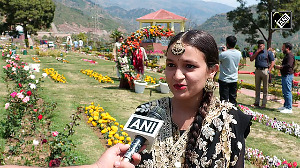 The Income Tax Department will get 20,751 additional hands, which would help it increase tax collections by over Rs 25,000 crore (Rs 250 billion) a year.
The Income Tax Department will get 20,751 additional hands, which would help it increase tax collections by over Rs 25,000 crore (Rs 250 billion) a year.
The Cabinet on Thursday approved a proposal to create an additional 1,349 additional posts in the Indian Revenue Services cadre and 19,402 in the non-IRS cadres.
An additional expenditure of Rs 450 crore (Rs 4.5 billion) per annum is likely to be incurred on the creation of additional posts and upgradation of some existing posts, Finance Minister P Chidambaram told reporters after the Cabinet meeting.
This additional expenditure would be more than compensated by the increased revenue of more than Rs 25,000 crore (Rs 250 billion) per annum, proposed to be generated as a result of this exercise, he said.
This means that an extra employee would add an extra Rs 1.2 crore (Rs 12 million) to the tax kitty, while he will cost an extra Rs 200,000 to the government a year on an average.
The move will also help the Income Tax Department provide better services to tax payers, the Finance Minister said.
Meanwhile, there is another proposal for a cadre restructuring of Central Board of Excise & Customs.
This will add 20,000 officers to its existing workforce of 66,808 officers, taking it to 86,808, and this may give an additional revenue of about Rs 68,000 crore (Rs 680 billion).
The CBEC's proposal may take a little longer as it is running behind CBDT proposal in terms of securing some key approvals.
The proposal was recently approved by Chidambaram. It will now have to be cleared by the Department of Expenditure and then, the Department of Personnel and
So, both the proposals would add to an extra Rs 93,000 crore (Rs 930 billion) a year to the government kitty.
This means that each employee will add to Rs 2.28 crore (Rs 22.8 million) a year to the government kitty on an average.
The additional revenue will be over and above the Budget Estimates of Rs 6,68,109 crore (Rs 6,681.09 billion) for direct taxes and Rs 5,65,002 crore (Rs 5,650.02 billion) for indirect taxes.
However, the entire workforce may not be added within this financial year even if the proposals are cleared soon.
The proposals were stuck for years and junior tax officers often threatened to go on strike for not getting promotion for years.
As per government guidelines, cadre review should happen every five years, but the last cadre review of CBDT was in 2001-2002, while it happened a year later in CBEC.
After the last cadre restructuring of CBDT, direct tax collections saw a quantum jump from Rs 70,000 crore (Rs 700 billion) in 2001-02, to Rs 1,05,000 crore (Rs 1,050 billion) in 2003-04 and Rs 1,33,000 crore (Rs 1,330 billion) in 2004-05.
CBEC too witnessed a jump in its collections from about Rs 1,22,000 crore (Rs 1,220 billion) in 2000-2001 to Rs 1,38,000 crore (Rs 1,380 billion) in 2002-03.
Though a higher number of senior positions would be created at both the boards, the staff expansion is likely to be mostly horizontal in CBDT, while the growth may be primarily vertical is CBEC.
For instance, in CBEC, 16 new posts have been proposed at the apex level and these officers would be called Principal Chief Commissioner.
Similarly, 38 additional posts are proposed in the Higher Administrative Group Plus category, which will include Chief Commissioners.












 © 2025
© 2025